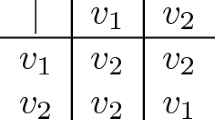Abstract
A uniform calculus for linear logic is presented. The calculus has the form of a natural deduction system in sequent calculus style with general introduction and elimination rules. General elimination rules are motivated through an inversion principle, the dual form of which gives the general introduction rules. By restricting all the rules to their single-succedent versions, a uniform calculus for intuitionistic linear logic is obtained. The calculus encompasses both natural deduction and sequent calculus that are obtained as special instances from the uniform calculus. Other instances give all the invertibilities and partial invertibilities for the sequent calculus rules of linear logic. The calculus is normalizing and satisfies the subformula property for normal derivations.
Similar content being viewed by others
REFERENCES
Avellone, A., Ferrari,M. and Miglioli, P.: 1999, Duplication-free tableau calculi and related cut-free sequent calculi for the interpolable propositional intermediate logics, Logic J. IGPL 7, 447-480.
Dyckhoff, R.: 1988, Implementing a simple proof assistant, in Derrick and Lewis (eds.), Proceedings of the Workshop on Programming for Logic Teaching, Leeds, 1987, Centre for Theoretical Computer Science and Departments of Pure Mathematics and Philosophy, Univ. of Leeds, no. 23.88, pp. 49-59.
Dyckhoff, R. and Pinto, L.: 1999, Permutability of proofs in intuitionistic sequent calculi, Theoret. Comput. Sci. 212, 141-155.
Herbelin, H.: 1994, A λ calculus structure isomorphic to Gentzen-style sequent calculus structure, in Pacholski and Tiuryn (eds.), Lecture Notes in Comput. Sci. 933, pp. 61-75.
Mints, G.: 1996, Normal form of sequent derivations, in Odifreddi (ed.), Kreiseliana, A.K. Peters, pp. 469-492.
Negri, S.: 2002, A normalizing system of natural deduction for intuitionistic linear logic, Archive for Mathematical Logic, in press.
Negri, S. and von Plato, J.: 2001a, Structural Proof Theory, Cambridge University Press.
Negri, S. and von Plato, J.: 2001b, Sequent calculus in natural deduction style, J. Symbolic Logic 66, 1803-1816.
Pfenning, F.: 2000, Personal communication.
von Plato, J.: 2000, A problem of normal form in natural deduction, Math. Logic Quarterly 42, 121-124.
von Plato, J.: 2001, Natural deduction with general elimination rules, Arch. Math. Logic 40, 541-567.
von Plato, J.: 2002, Translations from natural deduction to sequent calculus, Paper presented at the conference Natural Deduction, Rio de Janeiro, July 2001.
Prawitz, D.: 1965, Natural Deduction, Almqvist and Wiksell, Stockholm.
Schroeder-Heister, P.: 1984, A natural extension of natural deduction, J. Symbolic Logic 49, 1284-1300.
Troelstra, A. S.: 1992, Lectures on Linear Logic, CSLI Lecture Notes 29, Stanford University.
Ungar, A. M.: 1992, Normalization, Cut-Elimination and the Theory of Proofs, CSLI Lecture Notes 28, Stanford University.
Valentini, S.: 1992, The judgement calculus for intuitionistic linear logic: Proof theory and semantics, Z. Math. Logik Grundlag. Math. 38, 39-58.
Author information
Authors and Affiliations
Rights and permissions
About this article
Cite this article
Negri, S. Varieties of Linear Calculi. Journal of Philosophical Logic 31, 569–590 (2002). https://doi.org/10.1023/A:1021264102972
Issue Date:
DOI: https://doi.org/10.1023/A:1021264102972




